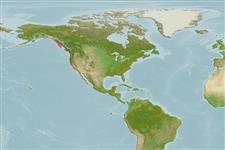>
Perciformes/Cottoidei (Sculpins) >
Cottidae (Sculpins)
Etymology: Synchirus: Greek, syn, symphysis = grown together + Greek, cheir = hand (Ref. 45335); gilli: Named after Theodore Gill, U.S. ichthyologist (Ref. 6885).
More on author: Bean.
Environment: milieu / climate zone / depth range / distribution range
Ekologi
marina bottenlevande. Temperate; 59°N - 32°N
Eastern Pacific: Sitka, Alaska to San Miguel Island, southern California, USA.
Length at first maturity / Size / Vikt / Age
Maturity: Lm ?, range 5 - ? cm
Max length : 7.0 cm TL hane/ej könsbestämd; (Ref. 2850)
Short description
Morfologi | Morfometri
Taggstrålar i ryggfenan (totalt): 9 - 10; Mjukstrålar i ryggfenan (totalt): 20-21; Taggstrålar i analfenan 0; Mjukstrålar i analfenan: 20 - 21. Caudal fin rounded. Pelvic fins small.
Found in bays, tide pools and among kelp (Ref. 2850). Previously thought as rare species, but relatively common in some areas, especially kelp beds (Ref. 2850). Feeds on small crustaceans (Ref. 6885). Can cling to bottoms or pilings with its pectoral and pelvic fins (Ref. 2850).
Life cycle and mating behavior
Könsmognad | Reproduktion | Lek | Ägg | Fecundity | Larver
Eschmeyer, W.N., E.S. Herald and H. Hammann, 1983. A field guide to Pacific coast fishes of North America. Boston (MA, USA): Houghton Mifflin Company. xii+336 p. (Ref. 2850)
IUCN Red List Status (Ref. 130435)
Threat to humans
Harmless
Human uses
Ytterligare information
Age/SizeTillväxtLength-weightLength-lengthLength-frequenciesMorfometriMorfologiLarverLarvdynamikRekryteringAbundansBRUVS
referenserVattenbrukVattenbruksprofilAvelslinjerGenetikElectrophoresesÄrftlighetSjukdomarBehandlingNutrientsMass conversion
MedarbetareBilderStamps, Coins Misc.LjudCiguateraHastighetSimsättGälytaOtolithsHjärnstorlekSyn
Verktyg
Special reports
Download XML
Internet-källor
Estimates based on models
Preferred temperature (Ref.
123201): 6.4 - 12.8, mean 9.3 °C (based on 242 cells).
Phylogenetic diversity index (Ref.
82804): PD
50 = 1.0000 [Uniqueness, from 0.5 = low to 2.0 = high].
Bayesian length-weight: a=0.00676 (0.00300 - 0.01523), b=3.17 (2.98 - 3.36), in cm total length, based on LWR estimates for this (Sub)family-body shape (Ref.
93245).
Trofisk nivå (Ref.
69278): 3.5 ±0.50 se; based on food items.
Resiliens (Ref.
120179): Hög, lägsta populationsfördubblingstid mindre än 15 månader (Preliminary K or Fecundity.).
Fishing Vulnerability (Ref.
59153): Low vulnerability (10 of 100).
Nutrients (Ref.
124155): Calcium = 154 [59, 376] mg/100g; Iron = 0.488 [0.222, 1.170] mg/100g; Protein = 17.1 [14.9, 19.3] %; Omega3 = 0.838 [0.328, 2.461] g/100g; Selenium = 12.3 [5.0, 33.6] μg/100g; VitaminA = 38.6 [9.2, 144.8] μg/100g; Zinc = 0.969 [0.601, 1.751] mg/100g (wet weight);
